
|

| Shakya Janapada
Silver 5-shana
c. 500 BCE
Weight:7.05 gm., 25 x 21 mm.
Several punch-marked symbols
with central pentagonal symbol/
blank |
 |
Perhaps some of the earliest known coins from India, these crude punch-marked coins were first found in the town of Narhan in modern-day Uttar Pradesh. This coin is especially interesting, because the coin's pentagonal shape echoes the shape of the main central symbol. |
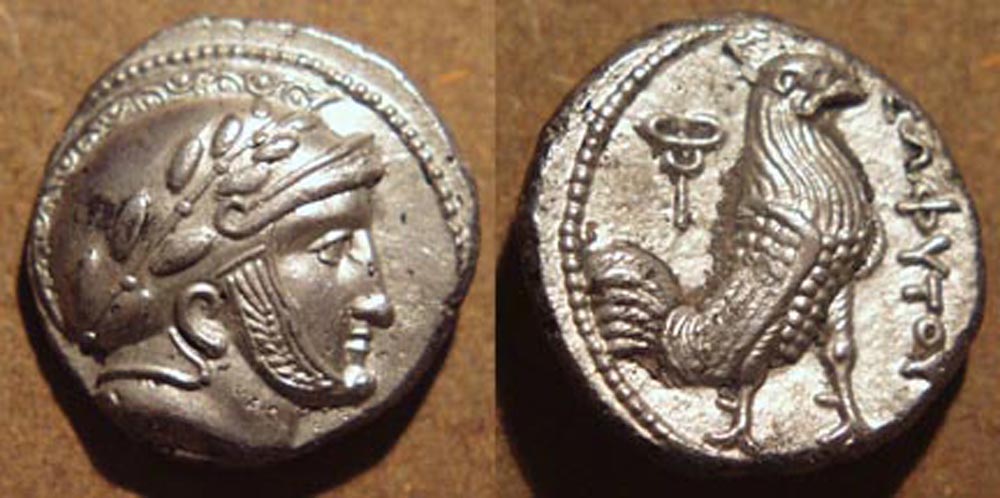
| Bactria: pre-Seleucid
Sophytes
Silver Drachm, late 4th century BCE
Weight:3.79 gm., Diam:14 mm., Die axis:6h
Helmeted bust of Sophytes facing right/
Cock standing right, cadeucus behind
Greek legend: ΣΩΦYTOY (of Sophytes) |
 |
Nobody knows who Sophytes was. Cunningham thought he was the Indian prince Sopeithes; others think he was a Persian starap. Whoever he was, he certainly had a master celator in his service, as evidenced by this masterpiece of a coin. |
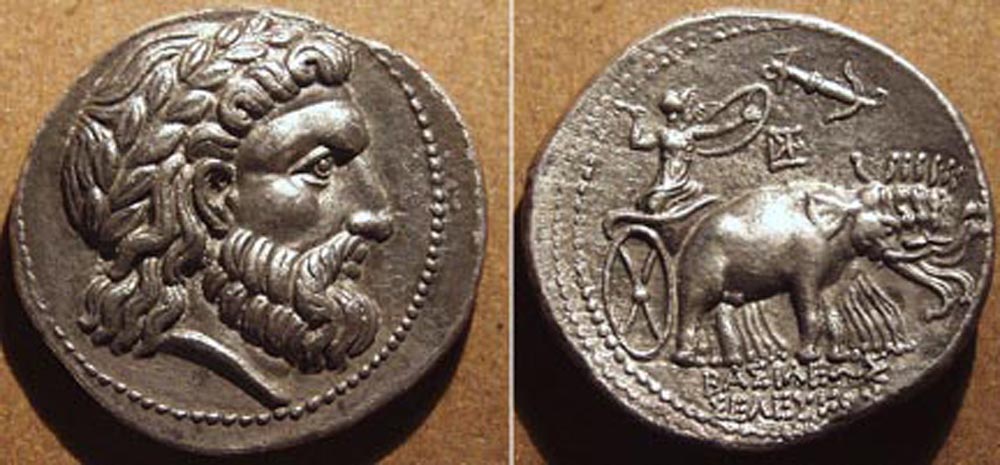
| Bactria: Seleucid
Seleucos I
Silver Tetradrachm, c. 290 BCE
Weight:16.87 gm., Diam:26 mm., Die axis:6h
Diademed, bearded bust of Zeus right/
Athena driving elephant quadriga
Greek legend: BAΣIΛEΩΣ ΣEΛEYKOY (of King Seleucos)
Ref: MIG 52 |
 |
This magnificent specimen of the Greek celator's art was issued by Seleucos I after he had established the Seleucid kingdom. Note the monogram for Bactra on the reverse (similar to the one we saw on the imitation Athenian owl of the so-called pre-Seleucid period). Also note the Seleucid anchor above. |
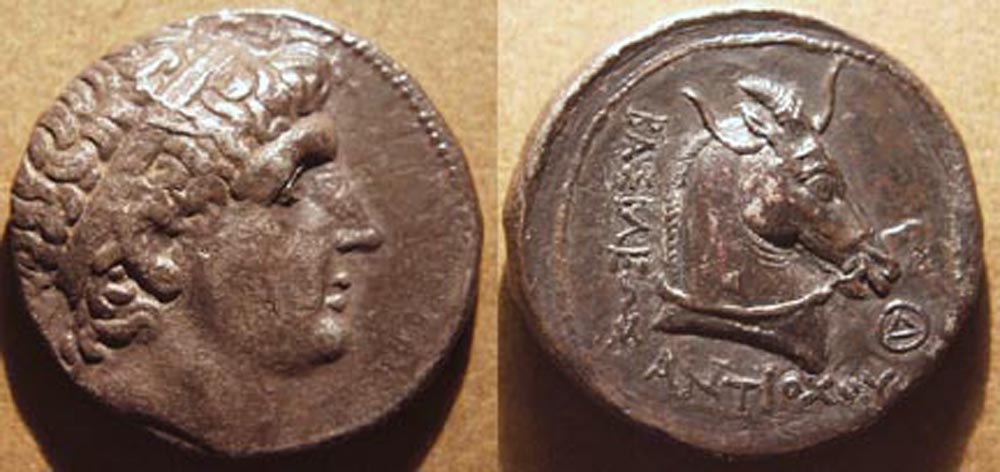
| Antiochos I
Silver Tetradrachm, c. 270 BCE
Weight:16.37 gm., Diam:25 mm., Die axis:6h
Diademed, bust of Antiochos right/
horned horsehead right
Greek legend: BAΣIΛEΩΣ ANTIOXOY (of King Antiochos)
Ref: MIG 54b |
 |
Once Antiochos I became king, he initiated a coinage with the head of Alexander's horse, Bucephalus, on the reverse. The deification of Alexander was in full swing! Note the Δ monogram, indicating this coin was minted in Ai-Khanoum. |

| Bactria: Diodotos I
in the name of Antiochos II
Gold stater, c. 250 BCE
Weight:8.15 gm., Diam:17 mm., Die axis:7h
Bust of Diodotos facing right/
Zeus standing left, hurling thunderbolt
Greek legend: BAΣIΛEΩΣ ANTIOXOY(of King Antiochos) |
 |
This coin marks the emergence of the Bactrian kingdom. Diodotos, who was probably the Seleucid king Antiochos II's governor in Bactria, declared his independence by placing his own bust on the coins. Eventually, he even replaced Antiochos's name with his own. |
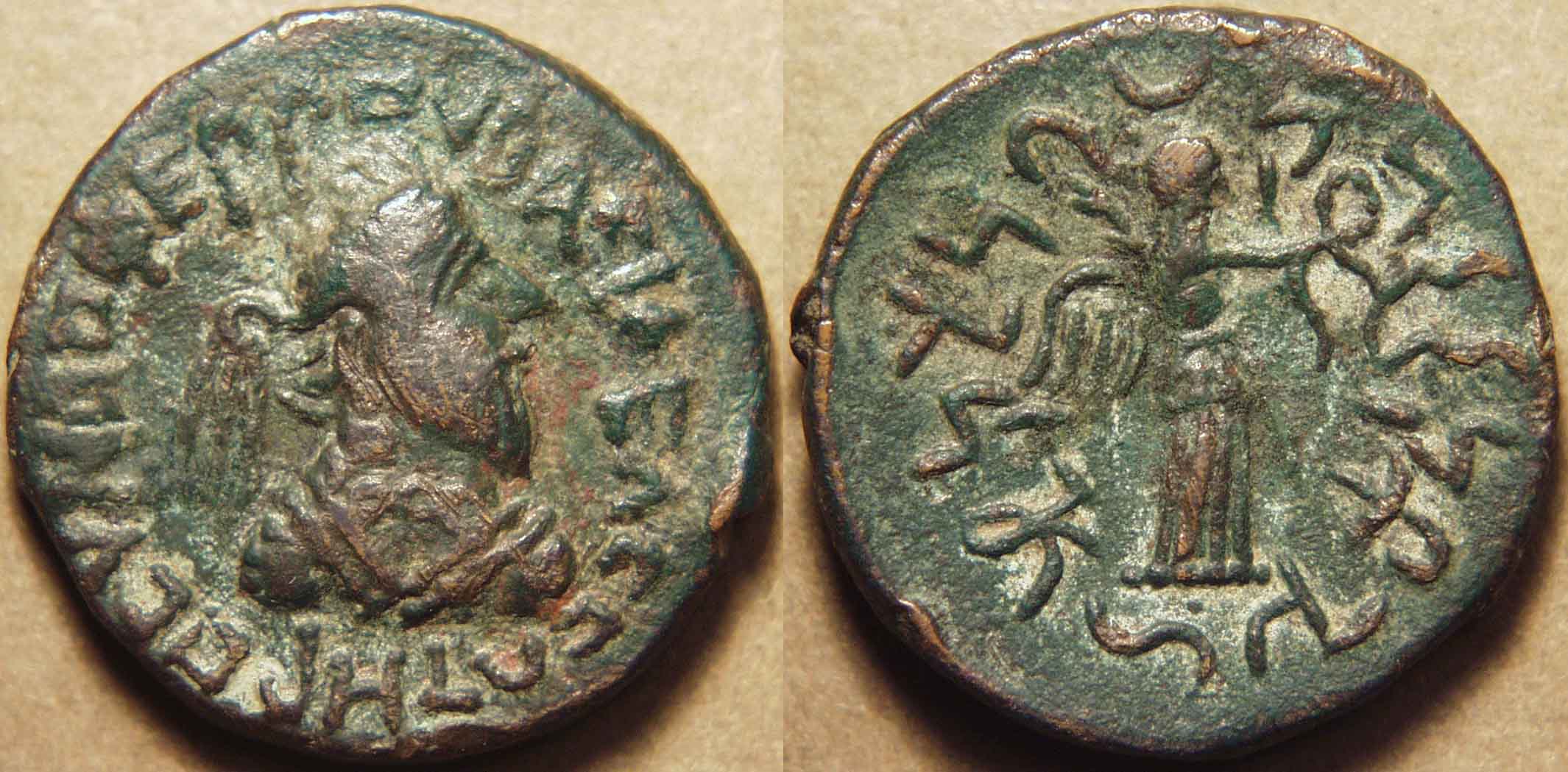
| Indo-Scythian: Gondophares
AE octodrachm, c. 50-10 BCE or c. 20-55 CE
Weight:19.10 gm., Diam:27-28 mm., Die axis:11h
Bust of Gondophares facing right
Greek legend: BACIΛEΩC CΩTHPOC VNΔOΦEPPOV
(of King Gondophares, the Saviour)/
Winged Nike standing right, holding diadem
Kharoshti legend: Maharajasa Gudaphanisa tratarasa |
 |
The date of Gondophares is a matter of great contoversy. He has been equated with one "King Gudnaphar" mentioned in the Apocryphal Acts of St. Thomas, an early Christian text. As St. Thomas met this King Gudnaphar, the date for Gondophares necessarily had to be no earlier than approximately year 20 CE. However, Robert Senior has argued that the King Gudnaphar of the Acts was probably Gondophares-Sases, who succeeded Abdagases, the successor to Gondophares I. On the basis of numismatic evidence, Senior dates Gondophares 70 years earlier than the conventional date.
This unique coin was published by Senior in the Newsletter of the Oriental Numismatic Society, No. 171 (Spring 2002). Copper tetradrachms of Gondophares, weighing approximately 9.5 gm., are very common, but this double-weight coin, at 19.10 gm., is the only one known of this denomination. |
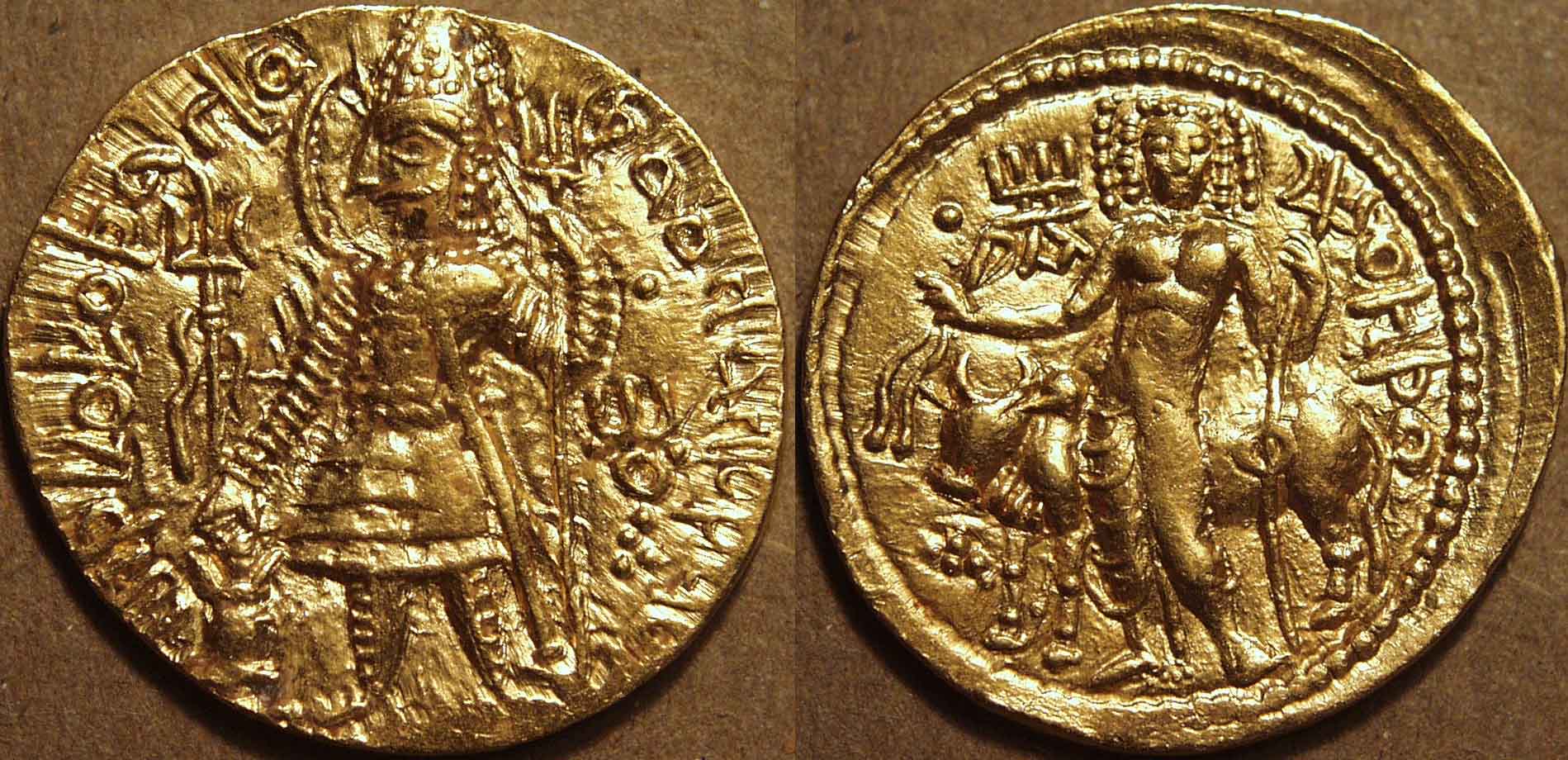
| Kushan: Kanishka II
Gold dinar, c. 227-247 CE
Weight:8.00 gm., Diam:23 mm., Die axis:1h
King standing left, sacrificing at altar
Bactrian legend: Shaonanoshao Kanishko Koshano
( King of Kings Kanishka)/
Oesho (Shiva) standing with bull (Nandi) |
 |
This coin, previously unpublished, is important because it is of the style of Vasudeva I (Göbl 655 and 657) but the legend clearly indicates it was issued by Kanishka II. This shows that the area where this coin was minted, probably Peshawar, but in any case somewhere in the northwestern parts of the kingdom, was not lost to the Kushano-Sasanians by Vasudeva, as has been long thought, but by Kanishka II. It also provides a link to the so-called "Xodeshah" coins, suggesting that those coins were also issued by Kanishka II. |

| Coin 21: Koziya, copper di-drachm
c. 235-265 CE
Weight: 3.87 gm., Diam: 20-21 mm.
King standing facing, head turned to right, Brāhmi legend at left: Koziya
Swastika turning right, Kharoshthi legend around (at 12 o'clock):
Koziyasa Kozanaputrasa Paratarajasa
(Of Koziya son of Kozana, Pārata King) |
 |
This seemingly insignificant copper coin has unlocked whole chapters of ancient Indian history! Because it has both a Brāhmi and a Kharoshthi legend, it served as a
sort of "Rosetta Stone" to unlock the name of this king: Koziya (previously read as Spajheya) and thereby helped to reorganize our understanding of the coinage of the
Pāratarājas. For more, see my 2009 paper. The coin is also helping re-write the
history of the Western Kshatrapas; for more on this, see the paper The Western Kshatrapa Dāmazāda, also forthcoming in the Numismatic Chronicle, 2009.
|
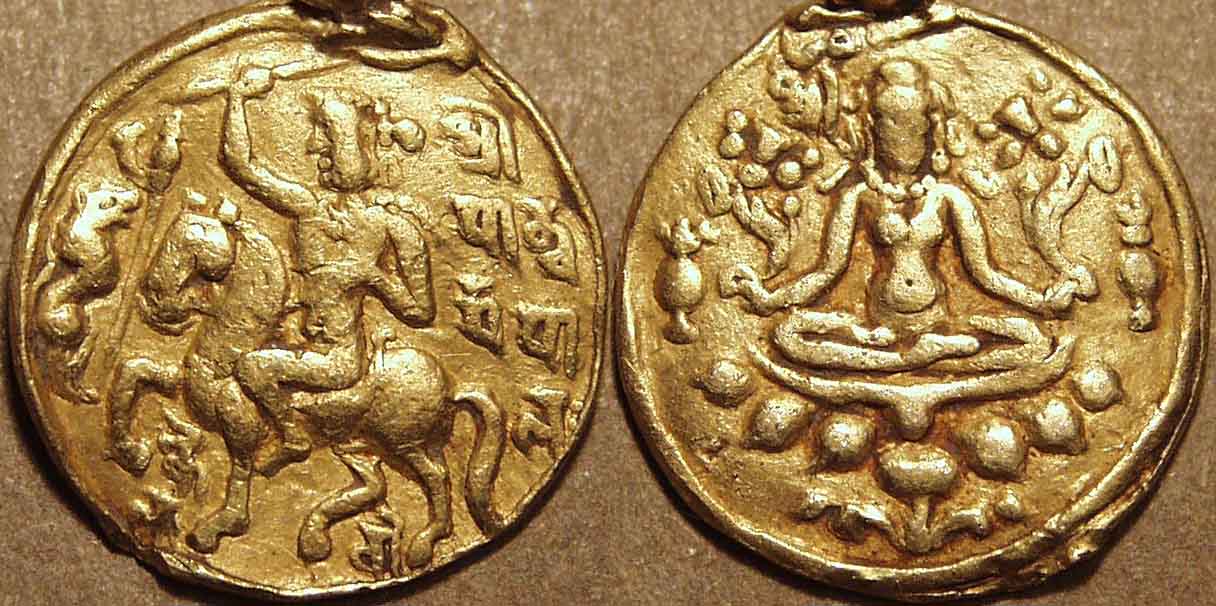
| Pāla: Dharmapāla
Gold dinar, c. late 8th or early 9th century CE
Weight (incl loop): 7.59 gm., Diam: 21 mm., Die axis: 12h
King riding horse left, brandishing spear
Animal (lion or boar?) at left, standard before king
Devanagari legend: Srimān Dharmapāla, kailavo (?))/
Lakshmi seated facing on a single lotus,
at top left: Sri |
 |
This extremely important coin is the first known coin of the great Pāla king, Dharmapāla. The Pālas were perhaps the most important dynasty to have ruled eastern India, particularly Bengal, and Dharamapāla has been called “one of the greatest kings that ever ruled in Bengal.” Buddhist art reached new heights under Pāla patronage (the Pāla rulers were themselves Buddhist) and Pāla art is said to have had profound influence on art throughout east and south-east Asia. For more on this coin, please see my paper which appeared in the Numismatic Chronicle, 2006. |
|